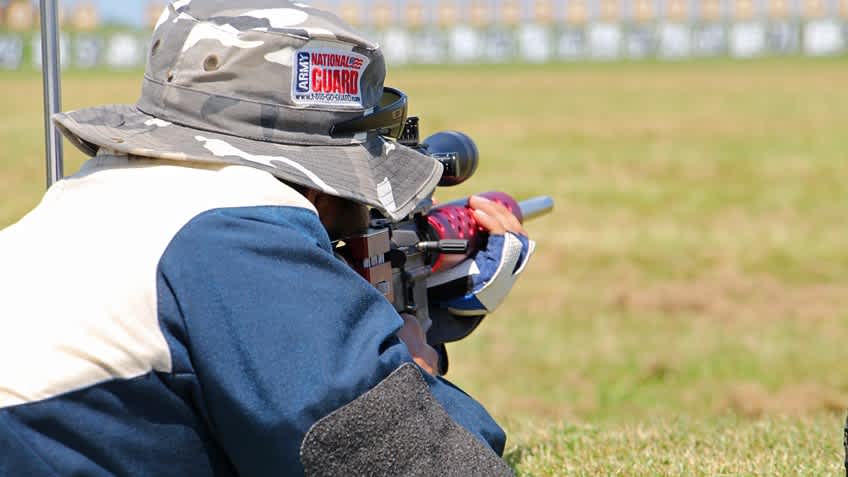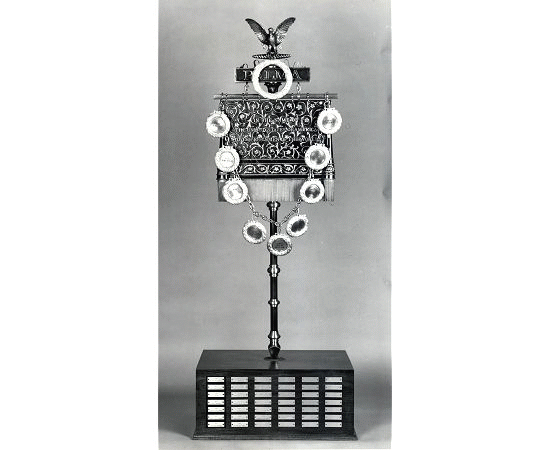Skill on Display at the 2015 World Long Range Shooting Championships
Tom McHale 08.19.15

Many shooters have heard the words “Camp Perry” spoken with a sense of awe and reverence. After all, Camp Perry, Ohio is where all the serious competitive rifle and pistol shooters gather for best of the best bragging rights. I’m not talking action competitions like USPSA Action Pistol or 3-gun. I’m talking about classic marksmanship with rifles and pistols. Long-range targets, precision, hundreds of competitors wearing those heavy leather shooting jackets. You know, the real deal.
Why the awe regarding Camp Perry? That’s where competitors do superhuman things like hit 1,000-yard distant targets with just 10-inch center bullseyes, using only iron sights. We’ll get to more about that in a minute.
Camp Perry isn’t about a single competition. It’s the home of dozens of competitions, one of which just wrapped up August 14, 2015. That would be the 2015 World Long Range Palma Championships. Just prior to that was the NRA High Power Rifle Long Range Championships. Many top competitors entered events for plenty of trigger time opportunity.
Before we talk about who won what, we ought to clarify a few things, mainly confusing words like Palma, ICFRA, and Creedmoor. We’ll assume that everyone reading this is familiar with the NRA, or National Rifle Association. The NRA provides more marksmanship and safety training than anyone, bar none. Sponsorship of big deal matches like these raises the bar for thousands of competitors from all over the world
ICFRA
Let’s talk about ICFRA first. That’s the International Confederation of Fullbore Rifle Associations. The name is plural because it encompasses long range shooting organizations from all over the world. Member countries span the globe from Australia to Kenya to Ukraine, plus eight others. Nineteen other countries participate as affiliate members with teams coming from countries including Barbados, Israel, Japan, Namibia, and Slovenia, just to name a few. As of now, two additional countries, Brazil and Romania, participate as observer members. Clearly the ICFRA includes a broad representation of marksmen from around the globe.
The ICFRA was proposed as an evolution of the Palma Council back in 1999, the idea being to create a true international confederation for long range shooting competition. The ICFRA was officially inaugurated in July 2003 during the Palma and Individual Long Range Championships at Bisley, United Kingdom.
What’s a Creedmoor?
Palma matches date back to 1876, when the international competition was held at the Creedmoor long range shooting facility. Back in 1872, the NRA and New York State opened a range facility on Long Island, at the Creed Farm. The National Matches were initially held there, at Creedmoor, until politics drove the competition to New Jersey, and later to their current location of Camp Perry, Ohio. The first Creedmoor match was the Great Centennial Rifle Match to celebrate 100 years of United States independence. Great Britain wasn’t as keen on the centennial thing as the individual groups from Scotland and Ireland, so the United Kingdom didn’t up entering a consolidated team. The United States team won the 1876 match at Creedmoor, followed by Ireland, Scotland, Australia and Canada, in that order.
What exactly is a Palma match?
It all started back in 1876. The original trophy for the Great Centennial Rifle match featured the word Palma. Apparently the ancient Latin translated to something like victorious, or perhaps glory. It didn’t take long for the recurring team competition to become known as a Palma match.

Nowadays, international Palma matches are characterized by a few main things: .308 Winchester cartridges, 800-, 900-, and 1,000-yard stages, and iron sights. In US-only matches, .223 Remington rifles are allowed as well as more variance in bullet weight, but international competitions put the emphasis on shooter skills instead of equipment optimization. Well, actually, there’s one more thing: Palma matches are all about team competition.
Targets are shot at ranges of 800, 900, and 1,000 yards. Each team member fires 15 shots at each distance from the prone position. Each shooter is allowed two sighting shots at each of the three distances. Team scores are totaled to determine the winner. While the overall target size is large, the V-Bull area is just 10-inches in diameter and the full bullseye area is just 20 inches. That’s an awfully small target for a 155-grain bullet fired from 1,000 yards using iron sights.
For the official international matches, teams must have 16 shooters, along with two alternates. The remainder of the 25 person roster is filled out by the coaching staff.
If the Palma match topic catches your fancy, I would highly recommend reading a comprehensive history of Palma competition written by Hap Rocketto.
The 2015 World Championships
Sponsored by the National Rifle Association, and hosted by Camp Perry, this event is comprised of 22 different shooting events. That’s because the whole program contains two separate competitions: the World Individual Championships and the Palma team matches.
During the three days of individual competition, categories of shooters include overall, under 25, under 21 and Veterans. There’s also a distinction for High Woman.
The 2015 overall individual awards were earned by:
World Long Range Championship Individual Results
- World Champion – Ben Emms (AUS) 669-77X
- 2nd Place – Nigel Ball (GBR)668-75X
- 3rd Place – Matthew Pozzebon (AUS) 666-78X
- High Woman – SSG Sherri Gallagher (USA) 593-64X
- High Veteran – Tom Whitaker (USA) 594-71X
- U25 World Champion – Jack Alexander (GBR) 590-55X
- U21 World Champion – Waylon Burbach (USA) 590-58X
You can check out the detailed final results on the NRA’s website.
The last three days are for the Palma match practice day and two days of Palma team competition for the 800-, 900-, and 1,000-yard segments.
Great Britain’s team took top honors with a team score of 7,106-825. Great Britain’s Toby Raincock also claimed the top individual shooter award within the Palma match, racking up a score of 449-55. The United States team claimed second place with 7,034-725 while South Africa finished third with 7,010-705.
This article was produced in cooperation with the NRA.

